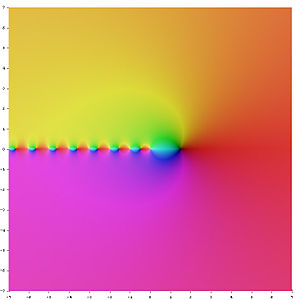- Digamma function
-
For Barnes's gamma function of 2 variables, see double gamma function.
 Digamma function ψ(s) in the complex plane. The color of a point s encodes the value of ψ(s). Strong colors denote values close to zero and hue encodes the value's argument.
Digamma function ψ(s) in the complex plane. The color of a point s encodes the value of ψ(s). Strong colors denote values close to zero and hue encodes the value's argument.
In mathematics, the digamma function is defined as the logarithmic derivative of the gamma function:
It is the first of the polygamma functions.
Relation to harmonic numbers
The digamma function, often denoted also as ψ0(x), ψ0(x) or
 (after the shape of the archaic Greek letter Ϝ digamma), is related to the harmonic numbers in that
(after the shape of the archaic Greek letter Ϝ digamma), is related to the harmonic numbers in thatwhere Hn is the n 'th harmonic number, and γ is the Euler-Mascheroni constant. For half-integer values, it may be expressed as
Integral representations
It has the integral representation
valid if the real part of x is positive. This may be written as
which follows from Euler's integral formula for the harmonic numbers.
Series formula
Digamma can be computed in the complex plane outside negative integers (Abramowitz and Stegun 6.3.16), using
or
This can be utilized to evaluate infinite sums of rational functions, i.e.,
 , where p(n) and q(n) are polynomials of n.
, where p(n) and q(n) are polynomials of n.Performing partial fraction on un in the complex field, in the case when all roots of q(n) are simple roots,
For the series to converge,
or otherwise the series will be greater than harmonic series and thus diverges.
Hence
and
With the series expansion of higher rank polygamma function a generalized formula can be given as
provided the series on the left converges.
Taylor series
The digamma has a rational zeta series, given by the Taylor series at z=1. This is
 ,
,
which converges for |z|<1. Here, ζ(n) is the Riemann zeta function. This series is easily derived from the corresponding Taylor's series for the Hurwitz zeta function.
Newton series
The Newton series for the digamma follows from Euler's integral formula:
where
 is the binomial coefficient.
is the binomial coefficient.Reflection formula
The digamma function satisfies a reflection formula similar to that of the Gamma function,
Recurrence formula and characterization
The digamma function satisfies the recurrence relation
Thus, it can be said to "telescope" 1/x, for one haswhere Δ is the forward difference operator. This satisfies the recurrence relation of a partial sum of the harmonic series, thus implying the formula
where
 is the Euler-Mascheroni constant.
is the Euler-Mascheroni constant.More generally, one has
Actually, ψ is the only solution of the functional equation
 that is monotone on
that is monotone on  and such that ψ(1) = − γ.
and such that ψ(1) = − γ.Gaussian sum
The digamma has a Gaussian sum of the form
for integers 0 < m < k. Here, ζ(s,q) is the Hurwitz zeta function and Bn(x) is a Bernoulli polynomial. A special case of the multiplication theorem is
and a neat generalization of this is
in which it is assumed that q is a natural number, and that 1-qa is not.
Gauss's digamma theorem
For positive integers m and k (with m < k), the digamma function may be expressed in terms of elementary functions as:
Computation & approximation
According to J.M. Bernardo AS 103 algorithm the digamma function for x, a real number, can be approximated by
or the asymptotic series
n as integer, where B(n) is the nth Bernoulli number for and ζ(n) is the Riemann zeta function.
Special values
The digamma function has values in closed form for rational numbers, as a result of Gauss's digamma theorem. Some are listed below:
See also
References
- Abramowitz, M. and Stegun, I. A. (Eds.). "psi (Digamma) Function." §6.3 in Handbook of Mathematical Functions with Formulas, Graphs, and Mathematical Tables, 9th printing. New York: Dover, pp. 258-259, 1972. See section §6.4
- Wimp, Jet (1961). "Polynomial approximations to integral transforms". Math. Comp. 15: 174–178. doi:10.1090/S0025-5718-61-99221-3.
- Weisstein, Eric W., "Digamma function" from MathWorld.
External links
- Cephes - C and C++ language special functions math library
- Bernardo, J. M.. "Algorithm AS 103 psi(digamma function) computation". http://www.uv.es/~bernardo/1976AppStatist.pdf.
 A020759 psi(1/2),
A020759 psi(1/2),  A047787 psi(1/3),
A047787 psi(1/3),  A200064 psi(2/3),
A200064 psi(2/3),  A020777 psi(1/4),
A020777 psi(1/4),  A200134 psi(3/4),
A200134 psi(3/4),  A200135 to
A200135 to  A200138 psi(1/5) to psi(4/5).
A200138 psi(1/5) to psi(4/5).
Categories:- Gamma and related functions
Wikimedia Foundation. 2010.
















![\Delta [\psi] (x) = \frac{1}{x}](0/3b05aa992d42e1ec553c927481c11530.png)














